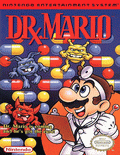
































Dr. Mario

Dr. Mario is a 1990 Mario arcade-style action puzzle video game designed by Gunpei Yokoi and produced by Takahiro Harada. Nintendo developed and published the game for the Nintendo Entertainment System and Game Boy consoles. The game's soundtrack was composed by Hirokazu Tanaka. The game focuses on the player character Mario, who assumes the role of a doctor and is tasked with eradicating deadly viruses. In this falling block puzzle game, the player's objective is to destroy the viruses populating the on-screen playing field by using colored capsules that are dropped into the field. The player manipulates the capsules as they fall so that they are aligned with viruses of matching colors, which removes them from play. The player progresses through the game by eliminating all the viruses on the screen in each level.
Dr. Mario received positive reception, appearing on several 'Best Nintendo Games of All Time' lists. The game was either ported, remade, or has had a sequel on every Nintendo home console since the NES as well as most portable consoles, including a re-release in 2004 on the Game Boy Advance as part of the Classic NES Series. Modified versions of Dr. Mario were included as minigames in WarioWare, Inc.: Mega Microgames! and Brain Age 2: More Training in Minutes a Day!.
Dr. Mario is a falling block tile-matching video game, in which Mario assumes the role of a doctor, dropping two-colored medical capsules into a medicine bottle representing the playing field. This area is populated by viruses of three colors: red, yellow, and blue. In a manner and style considered similar to Tetris, the player manipulates each capsule as it falls, moving it left or right and rotating it such that it is positioned alongside the viruses and any existing capsules. When four or more capsule halves or viruses of matching color are aligned in vertical or horizontal configurations, they are removed from play. The main objective is to complete levels, which is accomplished by eliminating all viruses from the playing field. A game over occurs if capsules fill up the playing field in a way that obstructs the bottle's narrow neck.
Players can select the degree of starting difficulty any time a new game is started. The initial level chosen is a value between zero and twenty that determines the number of viruses to clear, and the three game speed options change how fast the capsules fall in the bottle. The player's score is based solely on the elimination of viruses, not on the time taken to complete the level or the number of capsules used. If players complete the highest difficulty level, they can continue playing to accumulate a higher score, but the number of viruses to clear remains the same. Additional points are awarded when multiple viruses are eliminated at once, but no additional points are awarded for initiating chain reactions, in which the elimination of one set of objects triggers the elimination of another set. The game speed is also a factor in how the game calculates scoring; higher speed levels yield more points.
Dr. Mario offers a multiplayer gaming mode in which two players compete against each other in separate playing fields. In this mode, the player's goal is to clear their own playing field of viruses before the other player does. Eliminating multiple viruses or initiating chain reactions can cause additional capsules to fall onto the opponent's playing field. A player wins a single game upon eliminating all the viruses or if the other playing field fills up. The first player to win three games wins overall.
How to play:
Click on the joystick icon in the Dr. Mario online emulator to see how to control the Dr. Mario game









































Comments